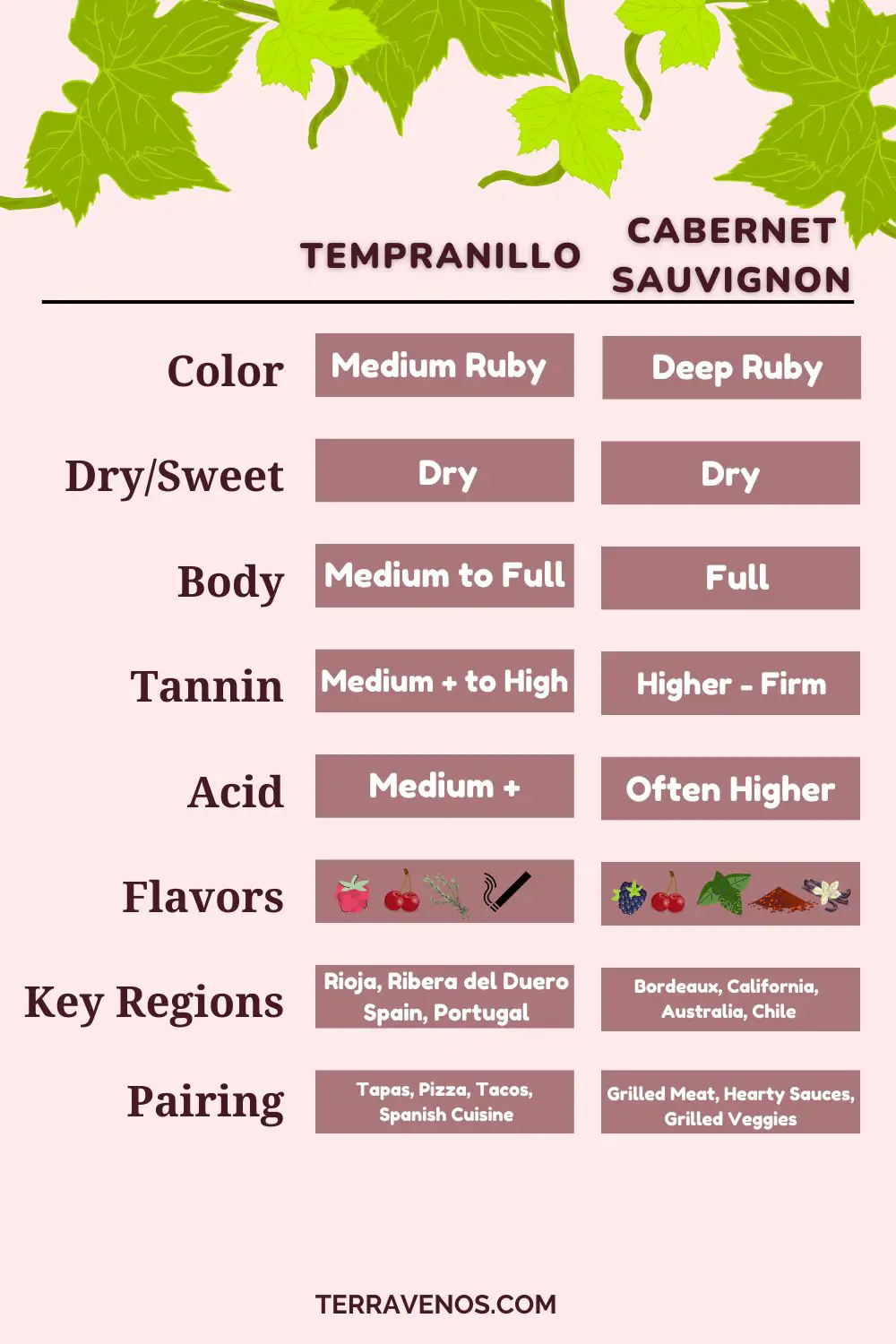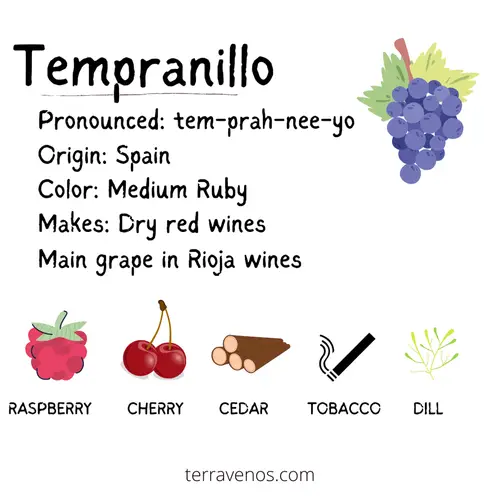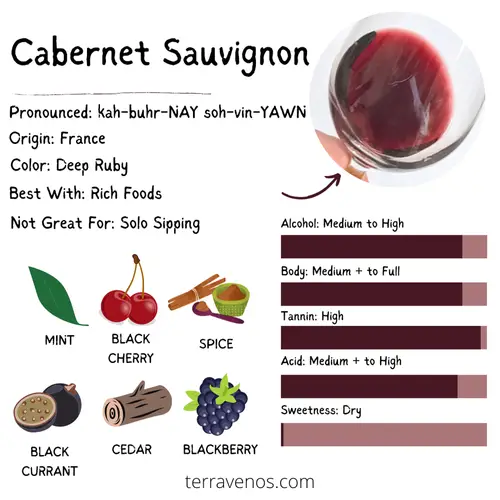
Tempranillo vs Cabernet Sauvignon is an interesting comparison if tasted separately. These are wines you’ll want to taste side-by-side to tease out the differences.
Tempranillo has red fruit and savory notes; Cabernet Sauvignon has black fruit and green notes. Cabernet Sauvignon is higher in alcohol, tannin, and body than most Tempranillos.
Comparing Tempranillo vs Cabernet Sauvignon is a perfect way to learn about these two rich red wines.
- Tempranillo Basics: Spain’s Red Wine
- Cabernet Sauvignon: The King of Bordeau
- Wine Comparison: Tempranillo vs Cabernet Sauvignon
- Tempranillo vs. Cabernet Sauvignon: Food Pairings and Serving Temperature
- Which Is Better, Tempranillo or Cabernet Sauvignon?
- Final Thoughts – Cabernet Sauvignon or Tempranillo?
- Thirsty for More?
Tempranillo Basics: Spain’s Red Wine

Tempranillo, a well-regarded grape originating from Spain, has gained worldwide recognition for its robust character. Now a global favorite, Tempranillo thrives in vineyards worldwide, from Spain’s Rioja and Ribera del Duero to New World regions.
With its deep crimson color, Tempranillo offers a palate of red berries complemented by subtle hints of coconut, herb, and cedar. This flavorful profile has made it popular among wine enthusiasts globally, securing its place in cellars.
Spain, the birthplace of Tempranillo, showcases its versatility from everyday wines to prestigious reserva and gran reserva selections.
Fun Wine Fact: Tempranillo gets its name from the Spanish word “temprano,” meaning early, as it usually ripens before many other grape varieties.
Helpful Tip: Here’s a complete guide to Tempranillo.

Cabernet Sauvignon: The King of Bordeau

Originating from Bordeaux, France, Cabernet Sauvignon has gained global recognition for its bold and structured nature. Today, it is widely cultivated in various wine regions around the world, including California, Chile, and Australia.
Fun Wine Fact: Cabernet Sauvignon is one of the main grapes that goes into Bordeaux wines.
Cabernet Sauvignon displays a full-bodied profile with pronounced tannins and flavors of blackcurrant, blackberry, and dark cherry. It often exhibits subtle notes of cedar, tobacco, and vanilla, which develop through aging in oak barrels. (Here’s a deep-dive into Cabernet Sauvignon wines.)
As one of the most popular red wine varieties, Cabernet Sauvignon is available at various price points. From everyday drinking options to premium selections crafted by renowned producers, there is a wide range of choices to suit different preferences.
Fun Wine Fact: Cabernet Sauvignon is often blended with other grape varieties, such as Merlot and Cabernet Franc, to enhance its complexity and balance.
Wine Comparison: Tempranillo vs Cabernet Sauvignon
Here’s a quick side-by-side comparison that covers the most common styles of Tempranillo and Cabernet Sauvignon:
| Characteristics | Tempranillo | Cabernet Sauvignon |
|---|---|---|
| Hue | Deep ruby to garnet | Deep red to purple |
| Color | Red | Red |
| Aromas | Red berries, cherry, tomato, coconut, leather | Blackcurrant, plum, ,mint, green bell pepper |
| Sweetness | Dry | Dry |
| Acid | Medium | Medium to high |
| Alcohol (%) | 13-14% | 13.5-15% |
| Body | Medium to full | Full |
| Intensity | Moderate to pronounced | Pronounced |
| Key Growing Regions | Spain (Rioja, Ribera del Duero) | France (Bordeaux), California, Australia |
| Classic Pairings | Grilled meats, tapas, chorizo | Steak, lamb, hard cheeses |
| Price Range | $10-$50+ | $10-$100+ |
Tempranillo Wine Profile
- Sweetness: Tempranillo is typically produced in a dry style, offering minimal residual sugar.
- Alcohol: Tempranillo wines generally have a low to moderate alcohol content, ranging from around 12% to 14% ABV.
- Body: Known for its medium to full body, the style of Tempranillo will depend on the growing region and winemaker.
- Flavor and Aroma Profile: Tempranillo has juicy red fruit, including cherry, plum, and tomato (tomato leaf); aged Tempranillo can get savory leather notes
- Tannins: Tempranillo has lower tannins than most Cabernet Sauvignon, but they can still be high, usually in the medium to high range.
- Acidity: Tempranillo usually has medium + to high acidity.
Cabernet Sauvignon Wine Profile
- Sweetness: Cabernet Sauvignon wines are dry, like Tempranillo.
- Alcohol: Cabernet Sauvignon wines are high alcohol (13%+)
- Body: Cabernet Sauvignon boasts a robust and full-bodied profile, accompanied by firm tannins.
- Flavor and Aroma Profile: Rich flavors of blackcurrant, blackberry, dark cherry, with notes of cedar, tobacco, and vanilla.
- Tannins: Cabernet Sauvignon tends to have more pronounced tannins than Malbec, contributing to its structure and aging potential.
- Acidity: Cabernet Sauvignon usually has high acidity.
Are Tempranillo and Cabernet Sauvignon Similar?
Both Tempranillo and Cabernet Sauvignon are red wines that can be oaked to give them spice and vanilla flavors. They are both red wines that get used in blends. Tempranillo goes into Rioja wines. Cabernet Sauvignon goes into Bordeaux wines.
What Is the Difference Between Tempranillo and Cabernet Sauvignon ?
Tempranillo has a savory quality to it, like tomato leaf, along with red fruit. Cabernet Sauvignon is black-fruit dominant (e.g., black currant and blackberry), and has an herbal minty quality.
Tempranillo vs. Cabernet Sauvignon: Food Pairings and Serving Temperature

Tempranillo: Tempranillo’s bright red fruit profile makes it an excellent pairing partner for earthy dishes, like lentil soup and paella. Check out: Tempranillo Food Pairing Guide
Cabernet Sauvignon: Cab’s full body, high alcohol, high tannin, and high acid mean that it will pair well with foods high in fat and protein. Think red meat, BBQ, and rich stews.
Both Tempranillo and Cabernet Sauvignon are best enjoyed at a slightly cool temperature. Place them in the refrigerator for about 10-15 minutes before serving.
Discover More:
Red Wine and Cheese Pairing: What You Need to Know
Tempranillo Cheese Pairing Guide
Cabernet Sauvignon Cheese Pairing
Which Is More Expensive, Cabernet Sauvignon vs Tempranillo?

Tempranillo and Cabernet Sauvignon do have an overlapping price-point, but Tempranillo wines won’t be as widely available depending on where you live in the world, they just don’t share Cabernet Sauvignon’s popularity. Hence, you’ll find extreme value Cabernet ($5), but you probably won’t find the same for Tempranillo.
Wine Price Ranges
| Wine Category | Entry-level Price Range | Premium Price Range |
|---|---|---|
| Tempranillo | $8 – $10 per bottle | Around $30 – $50 or higher |
| Cabernet Sauvignon | $12 – $20 per bottle | $30 – $100 or higher |
Helpful Tip: Here’s how a bottle of wine gets priced. This post is a little nerdy, but it’s quite complicated and nuanced depending on where you are in the world and where you’re buying your wine.
Tempranillo Cost
- Entry-level Tempranillo wines are typically affordable, ranging from $8 to $10 per bottle. If wine affordability is something you’re thinking about, you’ll find drinkable Tempranillo wines in most wine markets wherever you shop.
- If you are looking for premium Tempranillo wines, there are higher-priced bottles available. These bottles, priced around $30 to $50 or higher, offer a more complex and nuanced drinking experience.
Helpful Tip: Look for Rioja DOCG and Ribera del Duero DO quality wines made from Tempranillo. Look for affordable Tempranillo from La Mancha DO.
Cabernet Sauvignon Wine Cost
- Entry-level Cabernet Sauvignon wines range from $12 to $20 per bottle. These wines offer excellent value and showcase the varietal’s characteristic flavors and structure.
- As you move towards premium selections from renowned regions or iconic producers, prices can range from $30 to $100 or higher, reflecting their market demand, quality and aging potential.
Which Is Better, Tempranillo or Cabernet Sauvignon?

If you enjoy red wines with bright red fruit, a medium-full body, noticeable tannins, and a savory quality, then Tempranillo is the better wine for you. If you fuller body, higher tannins, higher alcohol, and herbal notes, Cabernet Sauvignon is the wine for you. If inexpensive wine is a deciding factor, you’ll find extreme value Cabernet Sauvignon under $5 USD.
Final Thoughts – Cabernet Sauvignon or Tempranillo?
Both Tempranillo and Cabernet Sauvignon have their wine personalities. Winealities. Cabernet Sauvignon is the wine I choose when serving savory roasted meats with protein and fat. Tempranillo is the wine I grab when I’m making a savory dish with herbs, lentils, and tomatoes.
I’m a big fan of side-by-side tastings to tease out the different wine characteristics. A great way to get started with these two wines is to do a side-by-side comparison.
Grab 2 bottles of similarly priced Tempranillo and Cabernet Sauvignon. Invite over a few friends and enjoy an evening of swirling and sipping
Discover: Spanish red wines you need to be drinking
Thirsty for More?
I’m a big believer in doing side-by-side tastings to boost your wine knowledge. Here’s how to host your own wine tasting for beginners.
Check out this post on Merlot vs. Pinot Noir, another popular red wine comparison, along with Shiraz vs. Malbec.
Here’s a full pairing guide for Tempranillo wine.



